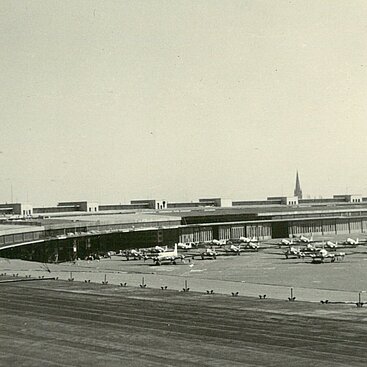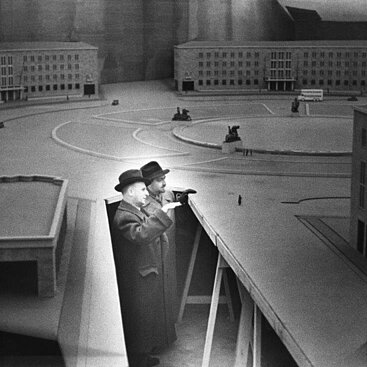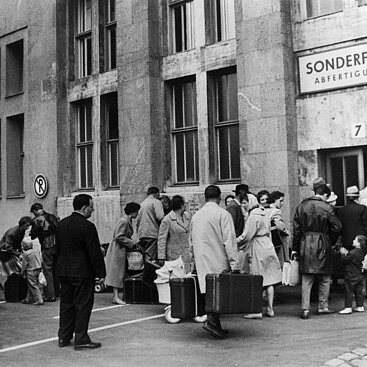Frühe Flugversuche
As military parade and training area, the Tempelhof field is a stage for previous flight attempts, in which the Berlin public takes part enthusiastically.
The balloon ride demonstrates its military benefit.
According to their experience during the Paris siege, the Prussian military starts to become interested in aviation towards the end of the 19th century. >From the end of 1870 onwards, gas balloons served as a kind of airlift, by means of which 9 tons of mail and 155 people were flown out of the city. 99 years after the first balloon ride, in 1884, 4 officers, 4 sergeants, 1 civil balloon pilot and 29 soldiers of the Prussian Railway Regiment no. 1 are posted by the Prussian Army in the new “Balloon Detachment”, which is positioned in Schöneberg on the western edge of the Tempelhof field. The aeronaut test department is affiliated with “Balloon Detachment” for the development of captive balloons among other things. In 1887, converted into the “Aeronaut Department”, the unit should primarily undertake awareness and observational functions. A balloon hall made of corrugated metal is constructed for research and testing of air and balloon ride on the Tempelhof field - now even exercise and demonstration ground for flight attempts. City gas nowadays serves as a cheap and easy to prepare filling agent mainly for conical and cigar-shaped dragon balloons. With increasing importance of balloon rides, the Aeronaut Department has expanded its regiment power and relocated the artillery shooting range to Tegel. Personnel: 13 officers, 1 doctor, 3 officials, 43 sergeants, 289 men, 4 economic craftsmen; 28 horses. First of all, balloon relocation purely for public entertainment is a thing of the past.
Advancement of science
In the 1890s, members of the German Association for the Advancement of Aviation, founded in 1881 in Berlin, were much talked about owing to their spectacular drives – even when their first balloon “Humboldt” was ill-starred as the initiator of the project pointed out. The balloon was manufactured by Continental in Hannover and acquired from the management fund of Kaiser with 12,000 marks. On 1st March 1893, it started for its maiden flight from the Tempelhof field in the presence of His Majesty, exploded and burned just two months later during landing. There were no casualties.
Renowned professors and doctors of the Royal Meteorological Institute could not prevent this from happening and now use the balloon drive for serial measurements of atmospheric pressure, atmospheric temperature and humidity at increasing altitudes. They want to study the atmosphere. Thanks to the support of astronaut-lieutenant Hans Groß, they undertook a total of 75 scientific drives.
On the way to dirigible balloon
In the beginning of the 20th century, international balloon races increased the general interest in evolving aviation. In 1905, the American publisher James Gordon Bennet offered a prize for the races; in just 1908, the race came to Berlin. A vast number of spectators gathered on the Tempelhof field and enjoyed the best view of the mass start free of charge. 23 balloons from eight countries were launched at the start; Schmargendorf gas works provided 22,000 m³ gas. Oberst Schaeck from Switzerland, who flew more than 1200 km to Norway in 73 hours in the balloon “Helvetica”, received the prize money of 125,000 francs.
Schaeck had not selected this destination; the wind determined the direction of his rudderless balloon. This was the major limitation of balloon aviation which countered several aeronauts with promising attempts in the second half of the 19th century.
This includes the work of Georg Baumgarten and Dr. Hermann Wölfert, who introduced the first manoeuvrable wing airship in Berlin in 1882. For the Great Berlin Trade Exhibition of 1896, Wölfert came to Treptow with his manoeuvrable aerostat “Deutschland”, where he passed a few trial climbs in the still constrained balloon. The Prussian War Office granted him permission to use the balloon hall and the Tempelhof field for further experiments.
Supported by the command of the Aeronaut Department, a free ride of 25 minutes took place in March 1897. Three months later, Wölfert wanted to prove that his motor balloon was really manoeuvrable. On 12th June 1897, he started the airship with the young mechanic Robert Knabe. Many invited guests included ambassadors of different countries witnessed the demonstration. Purchase negotiations over the invention were already initiated in the event of success. Thousands of spectators curiously waited for the start. The first rise failed. In the second rise, the 28 m long dirigible balloon climbed around 200 m with the help of his 8 PS motor. Then the dirigible rudder suddenly began to vibrate. It was clearly damaged and could not fulfil its function. But Wölfert continued to steer southwards as a fire started from the motor towards the balloon. The airship exploded with a muffled bang; the balloon and the gondola collapsed blazing on the ground in Ringbahnstraße; both the occupants died instantly. Wölfert had handled an open fire in the gondola despite urgent warnings.
In late autumn of the same year, another spectacular drive took place from the Tempelhof field. The airship developed by David Schwarz was four times larger than Wölfert’s dirigible balloon and manufactured in rigid design. All parts are made of aluminium: the carrier frame in the form of a grid, shell, gondola, tax screw and drive propellers. The interior of the balloon is subdivided into several compartments, in which gas is successively introduced. The 38 m long cylindrical metal balloon is conical at the front and bluntly rounded at the rear; a completely new design. A Daimler motor with 16 PS drives the three screw propellers using belts.
An all-metal airship is introduced by Ernst Jagels in Berlin, a mechanic and mechanical engineer inexperienced in aeronautics. On 3rd November, he started the motor in the presence of numerous guests including military leaders and progressed against a fresh East wind as the control system suddenly failed. The airship drifted towards the west, rapidly lost height, hit the ground and got stuck; the airtight aluminium wall burst, the gas escaped, the gondola got damaged and the reinforced frame broke. That was the end. There were no sponsors after that.
Schwarz’s construction principle of the rigid frame subdivided into individual compartments gained acceptance. Among the observers of the ascent on Tempelhof field was a man who would pursue the idea: Ferdinand Graf von Zeppelin.
St. Endlich, M. Geyler-von Bernus, B. Rossié
Literature
District Office of Tempelhof, Berlin (editor), Landing on Tempelhof. 75 years of central airport – 50 years of airlift, exhibition catalogue, Berlin without date specification (1998)
District Office of Tempelhof (editor), The dream of flying. Fascination between art and technology, Berlin 1987
Frank Schmitz, Airport Tempelhof. Berlin’s Gateway to the World, Berlin 1997
Werner Schwipps, mega cigars and flying boxes. Images from the early period of aviation in Berlin, series of museum for transport and technology, Berlin 1984





